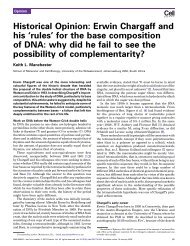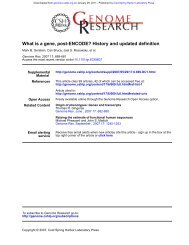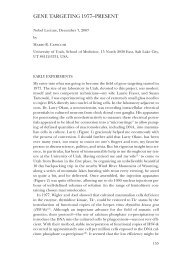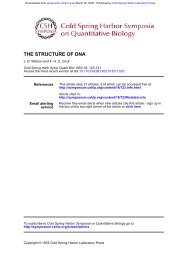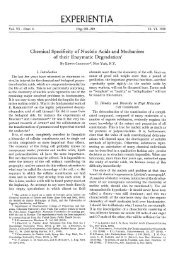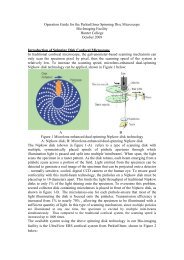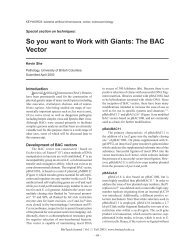Chargaffs Legacy.pdf - Biology
Chargaffs Legacy.pdf - Biology
Chargaffs Legacy.pdf - Biology
- No tags were found...
Create successful ePaper yourself
Turn your PDF publications into a flip-book with our unique Google optimized e-Paper software.
D.R. Forsdyke, J.R. Mortimer / Gene 261 (2000) 127±137 133two levels of evolution' (that of the genome phenotype andof the classical phenotypic) and considered `it is too easyjust to say most mutations are neutral'. However, non-adaptive`neutralist' explanations gained much support (Filipski,1990; Sueoka, 1995). Paul Sharp and his colleaguesconcluded (Sharp et al., 1993) that the main factors in¯uencingcodon choice are mutational biases and the need forhighly expressed genes to be ef®ciently translated. Althoughphenotypic adaptive factors such as the need to translate anabundant mRNA ef®ciently can in¯uence codon choice,genomic factors, identi®ed here as stem-loop potential(`fold pressure') and (C 1 G)%, play an important andoften dominant role.7. Thermophilic bacteriaThe secondary structure of nucleic acids with a high(C 1 G)% is more stable than that of nucleic acids with alow (C 1 G)%. GC bonds are associated with a more stablenucleic acid structure than AT or AU bonds. This isre¯ected in the base composition of RNAs whose structureis vital for their function, namely rRNAs and tRNAs. Free ofcoding constraints, yet required to form part of the precisestructure of ribosomes, rRNAs might more readily acceptmutations which increase GC content than do mRNAs.Indeed, the GC content of rRNAs is directly proportionalto the normal growth temperature, so that rRNAs of thermophilicbacteria are highly enriched in G and C (Dalgaard andGarrett, 1993; Forterre and Elie, 1993; Galtier and Lobry,1997). However, although optimum growth temperaturecorrelates positively with the GC content of rRNA, it doesnot correlate similarly with the GC content of genomicDNA, and hence with that of the mRNA populations transcribedfrom that DNA.The ®nding of no consistent trend towards a high genomicGC in thermophilic organisms has been interpreted assupporting the neutralist argument that variations in genomicGC are the consequences of mutational biases and are,in themselves, of no adaptive value (Filipski, 1990; Galtierand Lobry, 1997). However, the ®nding is also consistentwith the argument that genomic GC is too important merelyto follow the dictates of temperature, since its primary roleis related to other more fundamental adaptations (Bernardiand Bernardi, 1986).Galtier and Lobry (1997) have argued that `any secondarystructure that must endure high temperatures requires a highG 1 C content'. This would include both the classicalWatson-Crick secondary structure involving inter-strandbase pairing, and any secondary structure involving intrastrandbase pairing (Murchie et al., 1992). However, thestability of genomic DNA at high temperatures might beachieved in ways other than by an increase in GC content(Bernardi, 2000). These include association with polyamines(Oshima et al., 1990), and relaxation of supercoiling(Friedman et al., 1995). There is no reason to believe that inthermophiles DNA is not able to maintain both its classicalduplex structure with H-bonding between opposite strands,and any secondary structures involving intrastrand H-bonding.As we propose (see Section 9), the latter structureswould be critical only under certain clearly de®ned, butselectively very important, circumstances, namely whenrecombination repair is required. The most enduring DNAsecondary structure, even at high temperatures, would be theclassical duplex form.8. The `holy grail' of Romanes and BatesonWith hindsight it seems that, in identifying (C 1 G)% asthe species variant component of the base composition,Chargaff had uncovered what we might now recognize asthe `holy grail' of speciation ®rst postulated in 1886 byCharles Darwin's research associate, George Romanes(Forsdyke, 1999a,b). Romanes had pointed to what wewould now call non-genic variations in the germ-line,which would tend to isolate an individual reproductivelyfrom other members of its species, but not from membersthat had undergone the same variation. William Batesonfurther postulated a non-genic inherited variation, whichwould remain constant for a species, whereas genic variationscould occur within a species. The non-genic variations,in whatever was responsible for carrying hereditary informationfrom generation to generation (not known at thattime), would have the potential to lead to species differentiation,so that variant members of a species (`not-self')would not successfully reproduce with members of themain species (`self'). The latter would constitute the `reproductiveenvironment' moulding the genome phenotype(reprotype).Once reproductive isolation was achieved, the naturalselection postulated by Darwin would be able to furtherincrease species differentiation by allowing the survival oforganisms with advantageous genic variations, and disallowingthe survival of organisms with disadvantageousgenic variations. These genic variations would affect theclassical phenotype. Romanes referred to his holy grail(speciating factor) as an `intrinsic peculiarity' of the reproductivesystem. Bateson described his holy grail as aspeciating factor uniformly attached to the same `residue'as the genes, but distinct from the genes. These are just theproperties we ®nd in the (C 1 G)% (Forsdyke, 1996b,1998).A metaphor for the role (C 1 G)% might play in keepingindividuals reproductively isolated from each other isprovided by the word `dialect' (Grantham et al., 1986). Acommon language brings people together, and in this way isconducive to sexual reproduction. But languages can vary,®rst into dialects and then into independent sub-languages.Linguistic differences keep people apart, and this differencein the reproductive environment militates against sexualreproduction.



